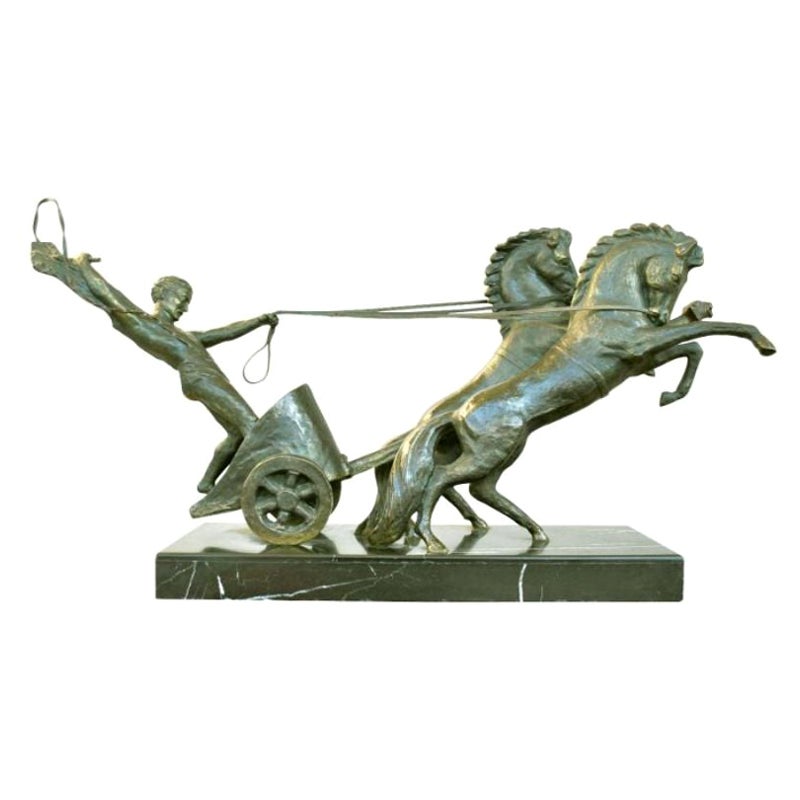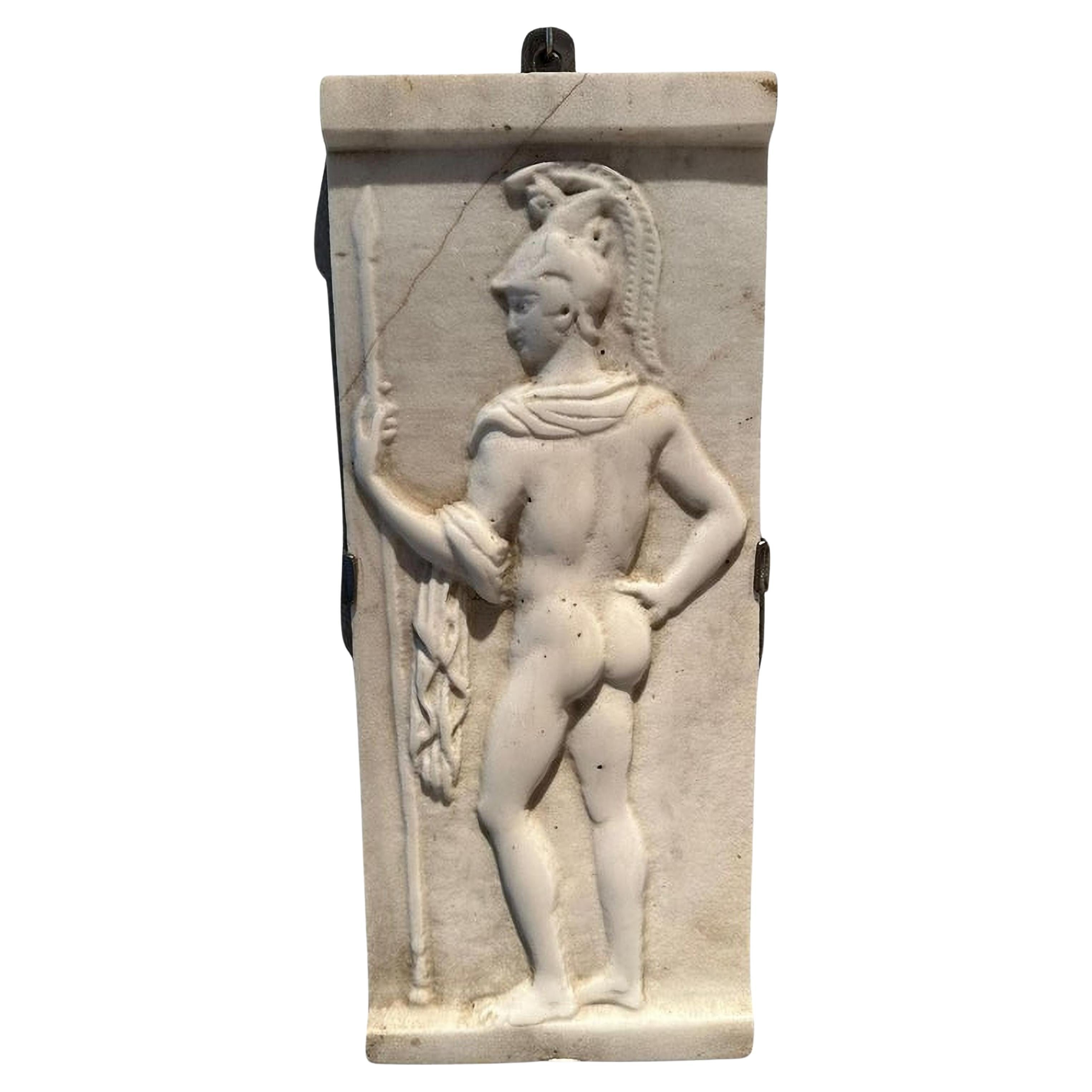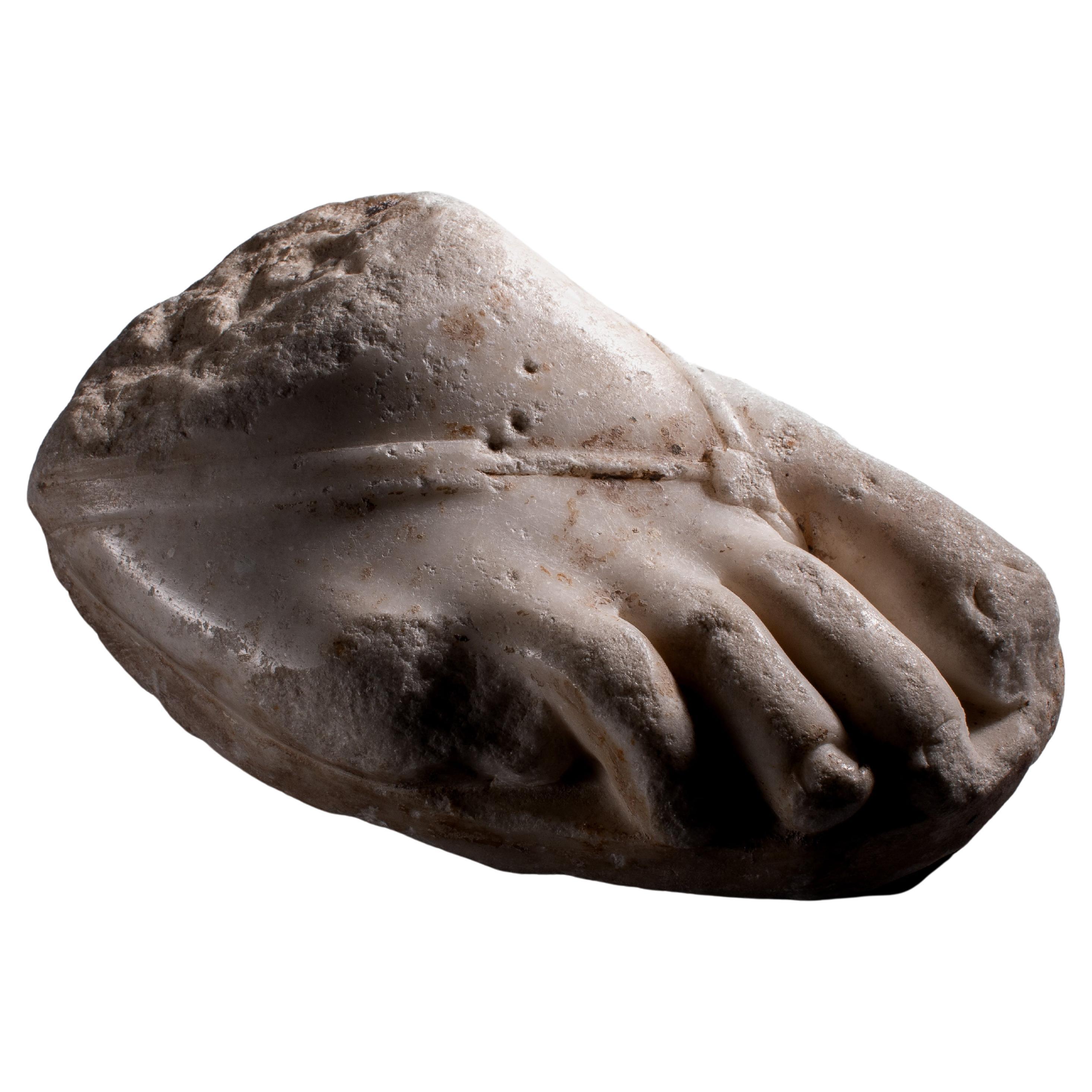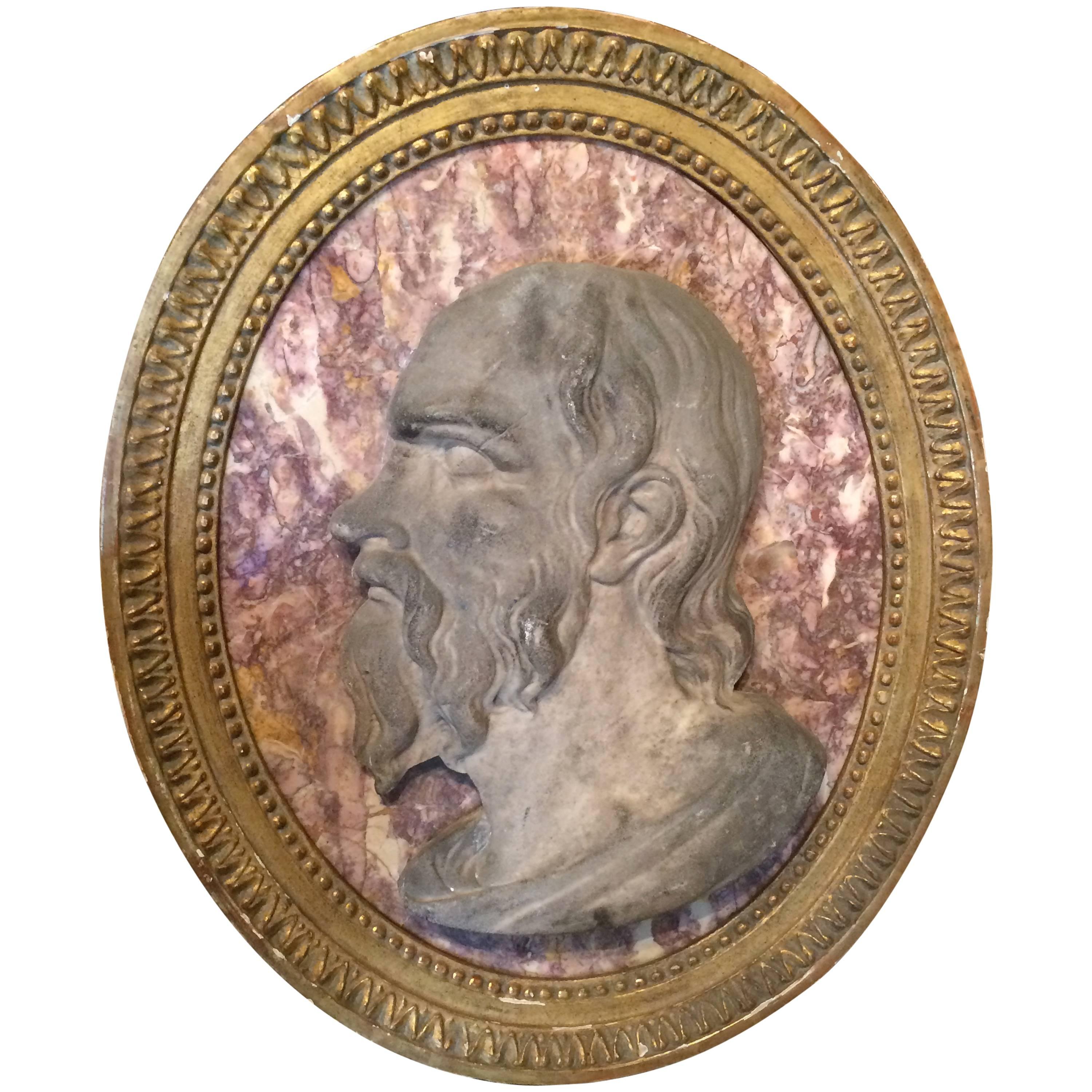Items Similar to Marble Roman relief representing a Christogram
Want more images or videos?
Request additional images or videos from the seller
1 of 6
Marble Roman relief representing a Christogram
About the Item
Marble Roman relief representing a Christogram
Roman relief - 4th century
25 x 22 x 8 cm
Provenance :
Collection of the Château de B. À Nevers by Georges C.S., scholar born in 1833 and deceased in 1909
The entire castle and its collections were acquired in 1938 by the current owners of the estate
A christogram is a monogram or combination of letters that forms an abreviation for the name of Jesus Christ.
This rare fragment combines chi (X) and rho (P), the first two letters of Christ's name in Greek and it is one of the oldest and most popular early christian symbol. The monogram of Christ, or chrismon, is also a powerful symbol of imperial victory: it appeared to Emperor Constantine the Great before his battle against Maxentius in ad 312, promising victory in the name of Christ. In Plato's Timaeus, it is explained that the two bands which form the "world soul" (anima mundi) cross each other like the letter Chi, possibly referring to the ecliptic crossing the celestial equator: And thus the whole mixture out of which he cut these portions was all exhausted by him. This entire compound divided lengthways into two parts, which he joined to one another at the centre like the letter X, and bent them into a circular form, connecting them with themselves and each other at the point opposite to their original meeting-point; and, comprehending them in a uniform revolution upon the same axis, he made the one the outer and the other the inner circle.
— Plato, Timaeus, 8.36b and 8.36c
The Alpha and Omega symbols may at times accompany the Chi-Rho monogram; in the present fragment the alpha is still visible, the omega was on the other side of the relief. The alpha and Omega letters on the side of the figure represented the Beginning and the End of the Apocalypse; Christ is the start and the End of everything.
This fragment is an early and rare testimony of the first Christian works. Other similar exemples of Chrismon are on display at the Louvre, at the Coliseum and at the Musée des Augustins in Paris (Reference : ME341).
- Dimensions:Height: 9.85 in (25 cm)Width: 8.67 in (22 cm)Depth: 3.15 in (8 cm)
- Style:Classical Roman (Of the Period)
- Materials and Techniques:
- Place of Origin:
- Period:
- Date of Manufacture:4th century
- Condition:Wear consistent with age and use.
- Seller Location:Bruxelles, BE
- Reference Number:1stDibs: LU6666234890972
About the Seller
5.0
Vetted Seller
These experienced sellers undergo a comprehensive evaluation by our team of in-house experts.
1stDibs seller since 2022
6 sales on 1stDibs
Typical response time: 5 hours
- ShippingRetrieving quote...Ships From: Bruxelles, Belgium
- Return PolicyA return for this item may be initiated within 3 days of delivery.
More From This SellerView All
- Cercle of Jacopo della Pila - Marble relief depicting a winged CherubLocated in Bruxelles, BECercle of Jacopo della Pila (Lombard, in Naples 1471-1502) Marble relief depicting a winged Cherub Naples, second half of15th century 40 x 57 x 12 cm Exquisitely carved, this relief portrays a winged cherub with cascading hair and delicate features. The cherub's plump, smooth countenance, rounded cheeks, outlined lips, and finely drawn nose emanate a sense of tenderness. The quadrangular module, is adorned with a carved frame. The relief ascends gradually, transitioning from the low relief of the wings to the high relief of the head. The rectangular frame and the subtly curved form of the artwork suggest that the relief likely adorned the upper part of an arch or a vaulted chapel. The type is that of the perspective room with a coffered ceiling decorated with figures of winged cherubs, which is found in various Neapolitan chapels of the 15th century. Coffered ceilings attest to the recovery of antiquity and the search for luxury in Renaissance architecture, first in Florence, then in Rome and Naples. The majority of the numerous family chapels and tombs built during the late fifteenth century in south of Italy employ the new formal vocabulary of the Florentine Renaissance in a self-confident manner that permitted a broad spectrum of variations. The escalating admiration for the classical world, coupled with the development of perspective, significantly contributed to the Renaissance endorsement of coffered ceilings. This artistic and constructive device drew inspiration from the intricate marble patterns observed in historical landmarks such as the Arch of Titus, the Temple of Vesta in Tivoli, the Pantheon, and the Basilica of Maxentius. A distilled product of both mathematical and artistic cultures, deeply scrutinizing the ancient world, the coffered ceiling plays a vital role in the perspective construction of space with its regular and directional geometry. The motif of the coffered ceiling decorated with cherubs in relief was introduced in Naples by Francesco Laurana in the plastic decoration of the Arch of Castelnuovo. Laurana's impact on the art scene in the south of Italy was profound. The introduction of the winged cherub into the region's artistic vocabulary bridged the gap between the classical and the contemporary, creating a synthesis that resonated with both aesthetic and spiritual sensibilities. His influence extended beyond the immediate visual appeal, shaping the cultural identity of the Renaissance in southern Italy. Although the plastic decoration of the Arch of Castelnuovo cannot certainly be ascribed to a mature Renaissance style, it was precisely on this occasion that the sculptors who worked there could get to know and export throughout the Italian peninsula that type of "Florentine classicism" which, even in the 15th century Naples, was conditioned by the Burgundian culture imported into the Kingdom by Alfonso of Aragon himself, with artists called from Spain and Northern Europe. The coffered ceiling, with its geometric patterns and Laurana's winged cherubs nestled within, became a symbol of refinement and cultural sophistication. The relief sculptures, carefully integrated into the overall design, transformed the ceiling into a celestial realm, inviting viewers to contemplate the divine while immersed in the grandeur of the Renaissance space. Similar winged cherubs appears also in the Naples cathedral. Within the renowned Succorpo Chapel, a mesmerizing marble coffered ceiling adorned with cherubs epitomizes the splendor of the Neapolitan Renaissance. The interplay of light and shadow on the textured surface of the marble coffered ceiling introduces an ethereal dimension, providing an immersive visual experience for observers. The geometric precision and the repeated patterns, reminiscent of classical motifs, establish a sense of harmony and balance that has become the hallmark of the Neapolitan interpretation of Florentine Renaissance aesthetics. Although probably intended to be admired from a distance, this cherub is intricately detailed and exquisitely rendered: the face and hair are elegantly outlined and the feathers are textured through juxtaposed lines. The marble, both figurative and decorative, adheres to the principles of balance and restrained ornamentation typical of the « Florentine Classicism ». Harmonious shapes and gracefully orchestrated curves , rooted in the classical repertoire, converge to evoke a sense of ethereal beauty. The surface displays the masterful use of a chisel to intricately carve the feathers and facial features, creating an almost abstract quality. This work is a testament to a sculptor of great skill and rich figurative knowledge, seamlessly blending classical firmness in contours with a refined treatment of the marble's surface. The combination of tradition and innovation point to a stylistic idiom from Lombardy, in particular we can find some comparaisons with the works of Jacopo della Pila, sculptor of Lombard origin working in Naples in the second half of the 15th century. He is documented there between 1471 and 1502, and is a protagonist of the Aragon Renaissance in the second half of the Quattrocento, together with the other great Northern sculptor active in the kingdom, Domenico Gagini. the first commission he received dates back to August 9, 1471, when Jacopo publicly committed to sculpting the funerary monument of Archbishop Nicola Piscicelli to be placed in the Cathedral of Salerno. The last known work is an altar ordered on July 29, 1502, by the noble Jacopo Rocco for the church of San Lorenzo Maggiore in Naples. Between these two chronological extremes (1471-1502), we must place the fervent activity of the artist, who had trained in Rome, perhaps under the guidance of Paolo Romano but also engaged in dialogue with other major artists of the city, especially Isaia da Pisa. He enriched his experience in Naples, initially drawing inspiration from the works of Domenico Gagini and later from the Tuscan masterpieces of Antonio Rossellino and Benedetto da Maiano destined for the church of Santa Maria di Monteoliveto. Jacopo della Pila's artistic personality is thus based on a complex interplay of influences, contributing to the definition of a highly personal style. Close comparaison can be made between our cherub and the winged angels reliefs...Category
Antique 15th Century and Earlier Italian Renaissance Figurative Sculptures
MaterialsMarble
- Telamon - Northern Italy, late 12th (Reemployed Roman marble)25000Located in Bruxelles, BETelamon Northern Italy, late 12th - early 13th century Reemployed Roman marble H 32 x L 18 x P 17 cm « Sono coloro che hanno dimenticato che l’uomo é solo un bruco, destinato a dive...Category
Antique 15th Century and Earlier Italian Medieval Figurative Sculptures
MaterialsMarble
- Gothic Stone Fragment Representing Vine Leaves, France, 15th CenturyLocated in Bruxelles, BEGothic architectural fragment representing vine leaves France, 15th century Sandstone H 21 x 21 x 17 cm mounted on a modern metal pe...Category
Antique 15th Century and Earlier French Gothic Architectural Elements
MaterialsLimestone
- Rare Romanesque Capital Representing Daniel in the Lion’s Den, 12th CenturyLocated in Bruxelles, BEEngaged Romanesque capital representing Daniel in the Lion’s den France, 12th century Limestone 38 x 29 x 18 cm Provenance : Private coll...Category
Antique 15th Century and Earlier French Medieval Architectural Elements
MaterialsLimestone
- Large Terracotta Relief - Lombardy, First Half of 17th CenturyLocated in Bruxelles, BELarge Terracotta relief of the flight into Egypt Lombardy, first half of 17th century Painted terracotta 91 x 85 x 11,5 cm This event in the early life of Christ is recounted i...Category
Antique 17th Century Italian Baroque Figurative Sculptures
MaterialsTerracotta
- Monumental Feminine Head - Roman Empire - 3rd-4th Century AdLocated in Bruxelles, BEVery large feminine head crowned by a tiara Roman period, 3rd - 4th century AD Eastern provinces of the Roman Empire (Palmira?) gray basalt H 55 cm Old collec...Category
Antique 15th Century and Earlier Syrian Greco Roman Figurative Sculptures
MaterialsStone
You May Also Like
- Bronze Representing Roman Chariot Marble Base by Michel DecouxBy Michel DecouxLocated in Marseille, FRNeoclassical bronze representing a Roman Chariot launched at full gallop mounted on a marble terrace. by Michel Decoux. Dimension: height 54 cm, total length 96 cm for a depth of 25 ...Category
Vintage 1930s Figurative Sculptures
MaterialsBronze
- Roman Relief "Warrior" late 19th Century in Carrara Marble With VideoBy Europa AntiquesLocated in Madrid, ESRoman Relief "Warrior" late 19th Century in Carrara Marble Italy 45cm x 19cm good condition for the timeCategory
Antique Late 19th Century Italian Classical Roman Figurative Sculptures
MaterialsCarrara Marble
- 19th Century British Carrara Marble Roman Relief Sculpture - Antique ReliefLocated in West Palm Beach, FLThis Carrara marble bas relief sculpture was hand carved in England in the late 1800s, in good condition. The antique relief sculpture depicts...Category
Antique 19th Century English Figurative Sculptures
MaterialsCarrara Marble
- Roman Marble FootLocated in London, GBRoman marble Fragment of a Right Foot with Sandal Circa 1st - 2nd Century A.D. An evocative Roman marble fragment, preserving the front portion of an over-lifesized sandalled foot. The toes, nails, and bridge of the foot have been sensitively carved. The outer sole of the sandal remains, with delicate, pointed straps joining between the first two toes in a diamond shape. This fragment once belonged to Danish sculptor Jens Adolf Jerichau...Category
Antique 15th Century and Earlier Italian Classical Roman Figurative Scul...
MaterialsMarble
- High Relief Representing Battle Skull -""Memento""By Europa AntiquesLocated in Madrid, ESHigh relief representing battle in classical style. carved on white Carrara marble dimensions 46 h x 45 x 10 cm, weight 35.5 kg Skull -""Memento"" sculpted in the smallest anatom...Category
Early 20th Century Italian Baroque Busts
MaterialsCarrara Marble
- 18th Century Roman Marble Relief Portrait of SenecaLocated in Stamford, CT18th century Italian marble relief portrait of the Roman Stoic philosopher Seneca, carved in deep relief and mounted on a red and white variegat...Category
Antique 18th Century Italian Neoclassical Figurative Sculptures
MaterialsMarble
Recently Viewed
View AllMore Ways To Browse
Chi Omega
Hermes Petasos
Let There Be Neon On Sale
Michelin Man Sculptures
Midcentury Italian school On Sale
Onyx Denis
Oriental Dahl Jensen Figurines
P Tereszczuk
Pedro Friedeberg On Sale
Rattan Motorbike
Retro Hat Pin Holders
Richard Teschner
Sandalwood Figure
Sandstone Figurines
Sylvia Hood Chalkware
Sylvia Hood Figurines
The Finding Of Moses Marble
Vantines Incense





